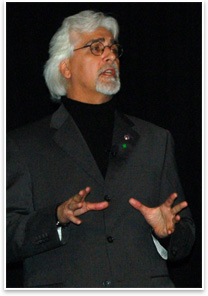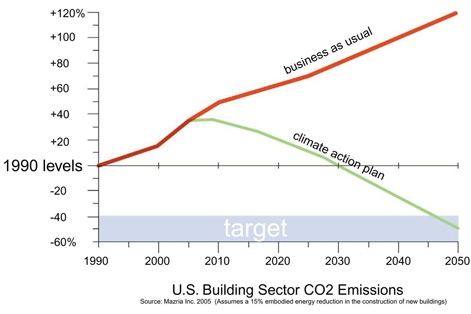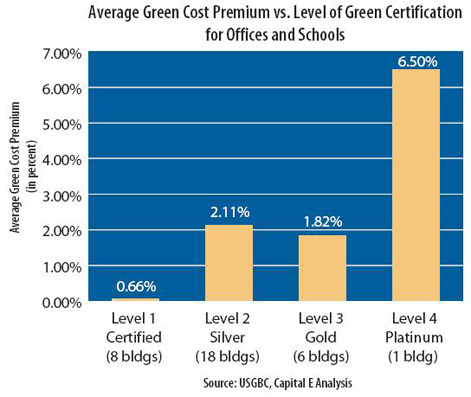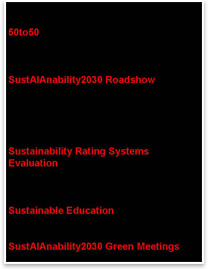
Summary: In one of his last public appearances as AIA president, RK Stewart, FAIA, presented the keynote address on stewardship in the built environment at the EcoBuild annual conference December 12 in Washington, D.C. The AIA sponsored Stewart’s talk. “I had the opportunity to travel the world during my term as AIA president, and I learned many things, including that our biggest challenge will determine what kind of ancestors we will be considered by future generations,” Stewart told the audience. Stewart was introduced by outgoing National Institute of Building Sciences (NIBS) President David Harris, FAIA, who presented Stewart as a “savvy institutional politician” as well as a “complete architect.” By that, Harris explained, he meant that Stewart understands the design, building, social, political, and economic facts of architecture, and knows when to give each one prominence. Harris noted that Stewart, as a principal of Gensler, one of the world’s largest architecture firms, not only has the skill to manage large projects but also is involved in advocacy for Gensler and the architecture profession at large. Harris also was pleased to announce that Stewart will be joining the board of directors of NIBS in January. Touching the tipping point
It is not difficult to believe that for “people as a species, this climate change is not a good thing,” Stewart said. Scientists predict that by 2070, sea changes will affect some 35 million people living in coastal regions. Stewart noted that a recent report by the United Nation’s Intergovernmental Panel on Climate Change (IPCC) indicates, with 90 percent confidence, that “human habitation is a main cause of climate change.” Even among people who believe that climate change is a dire issue caused in large part by humans, there exists misunderstanding of the causes, Stewart explained. A recent AIA survey of the general public indicates that 40 percent of those surveyed believe that cars and trucks are the leading cause of greenhouse gas and carbon emissions. In fact, Stewart noted, buildings are the biggest users of energy—roughly 40 percent of the carbon dioxide emissions come from buildings, and the U.S. tops the list of carbon producers. The greatest opportunity Buildings in fact could account for 20 percent of savings of projected energy use by 2030, Stewart said. He cited a report released December 5 by the McKinsey group, which says that buildings offer us the cheapest and least disruptive way to save energy. The AIA takes a stand Stewart also mentioned a number of initiatives the AIA has undertaken, including forming of collaborative relationships with groups that include the U.S. Conference of Mayors, which adopted the 2030 challenge in 2005, and the National Association of Counties, which adopted the challenge this year. Stewart also told the group about the AIA’s advocacy for federal action, including the Clean Energy Act and the Carbon Neutral Act. In fact, the energy bill just passed by Congress reflects 11 provisions from the AIA.
“Good design is sustainable design,” Stewart reiterated, citing a number of new sustainability tools available on the AIA Web site. He also presented a case study from the December 7 issue of AIArchitect, which featured the Colorado’s Signature Centre by Binh Vinh, AIA, a spec office building that achieved a LEED® Platinum rating at no extra cost above a standard building of its type and size in its region.
“It’s a question of whether we will choose to do something different,” Stewart said, recalling that former Vice President Al Gore, this year’s Nobel laureate, spoke to the AIA 2007 National Convention in San Antonio this past May about taking action to combat global warming. The enormous convention ballroom was so crowded, he said, that the fire marshal had to turn the overflow crowd away. The message resonated so with the audience that they awarded Gore with a long and loud standing ovation for his remarks. “On Saturday, I turn over the position of AIA president to Marshall Purnell, FAIA. When I return to my office on Monday, I know I’m going to do things differently,” Stewart concluded. “What are you going to do?” |
||
Copyright 2007 The American Institute of Architects. All rights reserved. Home Page |
||
home
news headlines
practice
business
design
recent related
› Walk the Walk
› McKinsey Releases Report on Greenhouse Gas Emissions
Read about the 2030 Challenge.
Read the KcKinsey Report.
Visit the AIA’s Sustainability Resource Center on the Institute’s Web site.
Find out what the AIA Committee on the Environment is doing.

 RK Stewart Walks the Walk at EcoBuild Conference
RK Stewart Walks the Walk at EcoBuild Conference

 What are you going to do?
What are you going to do?